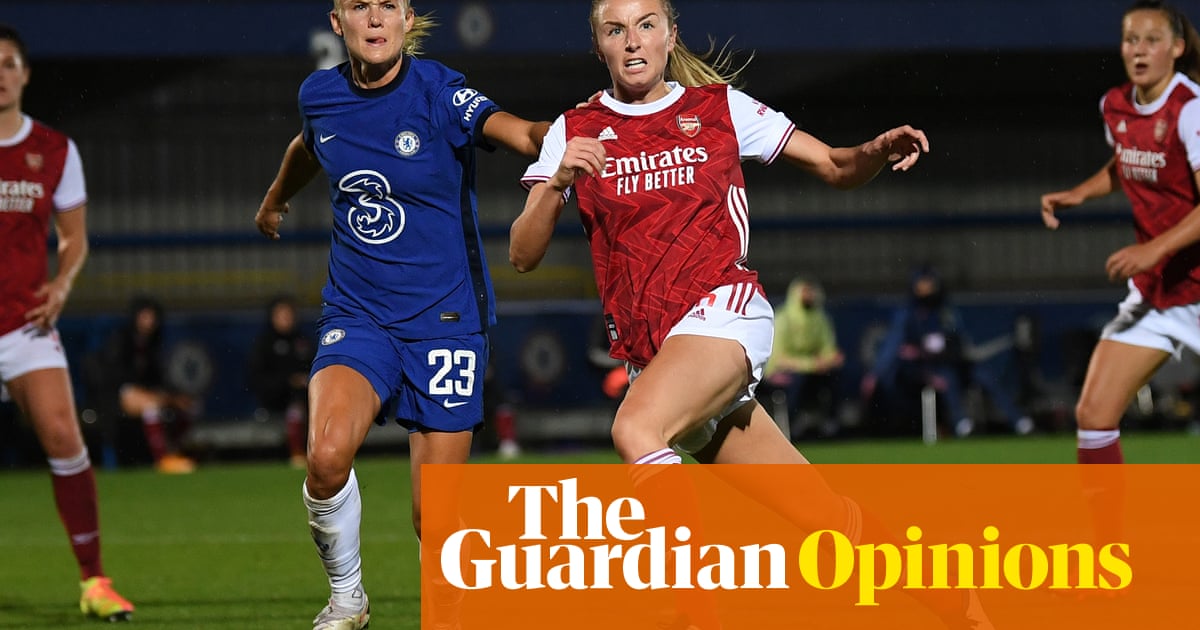
It all kicked off on women’s football Twitter this month. Not because of something Phil Neville said, which is the usual cause of button bashing, but as a result of TV coverage, or lack thereof.
Women’s football fans are a unique, loyal and opinionated tribe. So the news that very few of the first-round of games in the Continental Cup, including the mouth-watering Chelsea-Arsenal match, were going to be available to watch live went down like a lead balloon.
The Conti Cup, in which Women’s Super League and second-tier Championship sides take part, has not been around very long and is a competition that hasn’t always been a favourite among fans or reporters, partly as a result of its group-stage format but also because until last season it had only ever been won by Arsenal or Manchester City. There are also no fans at games and probably won’t be for a while longer. As the Guardian’s Suzanne Wrack put it on Twitter: “If no one can see it and no one can hear it, then does the Conti Cup actually happen?”
Full reruns were available to watch the next day for free on the FA Player, the platform that the FA launched last season, and clubs could opt to stream the fixtures themselves if they wanted to, an option that Manchester United, Manchester City and Lewes took up, but beyond that it was anyone’s guess how the goals went in. So historically low is the coverage of the Conti Cup that it is the first year the FA has even offered full replay and highlights of early-round games the next day.
Fans of women’s football are used to not being able to see games. They are used to struggling to find decent highlights or accurate stats and fighting to get the name of their favourite player on the back of a shirt in the club shop. But at the start of this season things felt different, like times were finally changing.
Two million people watched the season-opening edition of the Women’s Football Show, the BBC’s highlights programme for the WSL, and the US superstars Tobin Heath and Christen Press reportedly sold more shirts for Manchester United than any male player in the first three days after their signings were revealed. This all follows a record-breaking 2019 Women’s World Cup. The arrival of names such as Sam Kerr, Pernille Harder, Alex Morgan and Rose Lavelle alongside new international rights deals seemed to mark a turning point for English women’s football.
You may ask why it is so terrible that a League Cup competition isn’t on television, when the Carabao Cup often has games left off the schedule. But imagine if Messi, Ronaldo, Hazard and Mbappé had all decided that they were going to play in the Premier League one season, no fans were allowed to see them at stadiums and there was a near-blackout of several games.
There is undeniable demand for content, but the demand is not being met because most of the cost is falling on a governing body that is struggling financially. The FA is facing losses of around £300m and has already made 124 people redundant since Covid-19 halted football and kept fans away from stadiums.
To the FA’s credit, it has built a fantastic WSL alongside a fairly well-functioning digital platform where fans around the world can watch games and highlights for nothing. But in the long run it doesn’t feel sustainable to have a grassroots organisation bankrolling broadcast deals. The FA is being forced to justify costs at a time when every single department budget has been wiped. Right now it seems like a constant tussle at the FA between the elite competition and the grassroots game.
The FA needs help and it could get it from multiple sources, including domestic broadcasters. At present BT Sport and BBC show one live WSL game a week and the rest are on FA Player. The BBC picks up a selective number of Women’s FA Cup games and BT Sport normally shows the Conti Cup semi-finals and final. But there is no standalone rights deal for the whole of the Conti Cup. Even just picking up the blue-riband group tie of Chelsea-Arsenal would have appeased many fans.
Premier League clubs discussed a feasibility study into the possible takeover of the WSL this year, but it was then delayed. In June, Richard Masters, the Premier League chief executive, told the digital, culture, media and sport select committee that he wanted to see the league take control of the WSL. However, the Guardian revealed that the majority of clubs in the women’s top tier are against a Premier League takeover.
Liverpool and Manchester United’s Project Big Picture hinted at “a new independent league” that could be created alongside a reported injection of £51m into women’s football and a goodwill payment of £10m to the WSL and Championship for lost revenues from Covid-19. But a new league led by Premier League clubs, one of which has already shown its lack of interest in supporting a women’s team, doesn’t sound like a recipe for trust and success.
Sooner or later the FA will need to call in reinforcements to ensure that this huge momentum does not escape like the air from a cheap whoopee cushion. But what will it be willing to give up? The best-case scenario would be that fairly decent broadcast-rights deals come in for all the FA’s women’s competitions, the Barclays’ title sponsorship of the WSL is followed up with more investment from brands. And eventually, when the time is right and the keys to this exciting, growing product are handed over, who takes them will be the million-dollar question.
from Football | The Guardian https://ift.tt/35cW1YE
via IFTTT

No Comment